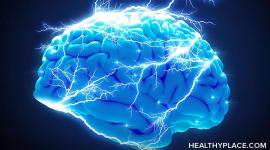Schizophrenia Brain: Impact of Schizophrenia on the Brain

While researchers and physicians can see the presence of abnormalities associated with schizophrenia in the brain by using Magnetic Resonance Imagery (MRI) and Magnetic Resonance Spectroscopy (MRS), there’s no real test for diagnosing the mental illness. In other words, if you are at risk for diabetes, doctors have definitive tests they can use to predict your risk and to monitor progression of the disease, if already present. Nothing like this exists for predicting and monitoring schizophrenia. (See: Early Warning Signs of Schizophrenia.)
Even so, the schizophrenia brain scans produced by sophisticated machines, like the MRIs and MRSs mentioned above, indicate structural differences in certain areas of the brain of affected people.
Abnormalities in the Schizophrenic Brain
Brain scans and microscopic tissue studies indicate a number of abnormalities common to the schizophrenic brain. The most common structural abnormality involves the lateral brain ventricles. These fluid-filled sacs surround the brain and appear enlarged in images of the brains of those with schizophrenia.
Neuroscientists from the National Institutes of Mental Health (NIMH) and other schizophrenia researchers report seeing up to 25 percent loss of gray matter in certain areas of the schizophrenic brain. Gray matter refers to certain areas of the brain involved in hearing, speech, memory, emotions, and sensory perception. The studies found that patients who had the most severe schizophrenia symptoms also had the highest loss of brain tissue.
Although significant brain tissue loss is a reason for concern, researchers have reason to believe that the loss of gray matter could be reversible. Researchers are working on drug studies, investigating new drugs that doctors can prescribe to reverse cognitive function loss associated with schizophrenia.
Hope from Scans of Schizophrenia in the Brain
Imaging scans of schizophrenia in the brain have helped researchers locate a small area of the brain that may help them predict whether people will develop schizophrenia with 71 percent accuracy for high-risk patients. The study results, which appear in the September 2009 issue of Archives of General Psychiatry, pinpoint the exact area of a part of the brain that shows hyperactivity in schizophrenics.
The researchers used high-resolution MRI equipment to show what areas of the brain are affected by schizophrenia. The scientists discovered three areas of the schizophrenic brain that differed from normal brains – two areas in the frontal lobes and one very small area of the hippocampus, known as CA1. We’ve always known that schizophrenics have a more active hippocampus, the area used for memory and learning, but this study pinpoints the exact spot of hyperactivity in patients with the illness.
This discovery brings new hope and promise to those at risk for developing a schizophrenic brain and for those already suffering from it. Doctors hope that once researchers further develop the findings, that they can use this as a diagnostic marker to predict whether certain high-risk patients will go on to develop full-blown psychosis after prodrome. They also hope to use the CA1 subfield marker in the hippocampus to indicate the efficacy of treatments. For example, a decreased amount of activity in the area could indicate the success of treatment strategies.
To view some interesting brain images of schizophrenia, along with associated explanations, click here. On the page, you’ll find links to MRI images showing the disease progression, a three-dimensional map of schizophrenic gene activity, and more.
APA Reference
Gluck, S.
(2021, December 29). Schizophrenia Brain: Impact of Schizophrenia on the Brain, HealthyPlace. Retrieved
on 2026, January 3 from https://www.healthyplace.com/thought-disorders/schizophrenia-effects/schizophrenia-brain-impact-of-schizophrenia-on-the-brain


